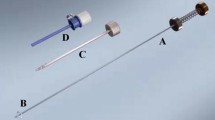Abstract
Introduction and hypothesis
To evaluate the effect of surgical instruments handling on polypropylene mesh using scanning electron microscopy (SEM).
Methods
We applied different surgical instruments, including a few robotic ones, to pieces of polypropylene mesh. SEM was used to evaluate the morphological changes with this intervention.
Results
Straight hemostat, laparoscopic atraumatic grasper, laparoscopic needle driver, and robotic instruments (Bipolar forceps, Cadiere™ forceps, PK™ dissecting forceps and SutureCut™) were applied to the mesh. SEM images of tool-affected mesh regions in specimens handled by different instruments along with the images of intact mesh were obtained. Average mesh fiber diameters, as well as the average parameters characterizing instrument-affected regions, were measured. There was substantial widening of the fibers in specimens handled by hemostat or a needle holder. An elliptical but much longer and narrower tool marking with more surface roughness was observed in mesh handled by a grasper. A ∼25-μm-wide and ∼200-μm-long strap was split on one side from the core of the fiber caused by Cadiere™.
Conclusions
There are morphological changes to polypropylene mesh caused by instrument handling. These changes are different depending on the instrument used. These alterations vary from changes in the surface creating roughness of the fiber, compression of the mesh with narrowing of the fiber in at least one direction or actual splitting or pitting of the fiber. Since there are no data regarding the effect of these morphological changes to the ultimate functioning of the mesh, surgeons should minimize mesh handling by instruments.







Similar content being viewed by others
References
Karlovsky ME, Kushner L, Badlani GH (2005) Synthetic biomaterials for pelvic floor reconstruction. Curr Urol Rep 6(5):376–384
Debodinance P, Berrocal J, Clave H, Cosson M, Garbin O, Jacquentin B et al (2004) Changing attitudes on the surgical treatment of urogenital prolapse: birth of tension-free vaginal mesh. J Gynecol Obstet Biol Reprod (Paris) 33(7):577–588
US Food and Drug Administration (2011) FDA Safety Communication: Update on Serious Complications Associated with Transvaginal Placement of Surgical Mesh for Pelvic Organ Prolapse. http://www.fda.gov/medicaldevices/safety/alertsandnotices/ucm262435.htm. Accessed 16 March 2013
(2008) Surgical repair of vaginal wall prolapse using mesh. National Institute for Health and Clinical Excellence. http://guidance.nice.org.uk/IPG267/Guidance/pdf/English. Accessed 16 March 2013
Clavé A, Yahi H, Hammou JC, Montanari S, Gounon P, Clavé H (2010) Polypropylene as a reinforcement in pelvic surgery is not inert: comparative analysis of 100 explants. Int Urogynecol J 21(3):261–270. doi:10.1007/s00192-009-1021-8
Ostergard DR (2011) Degradation, infection and heat effects on polypropylene mesh for pelvic implantation: what was known and when it was known. Int Urogynecol J 22(7):771–774. doi:10.1007/s00192-011-1399-y
Sternschuss G, Ostergard DR, Patel H (2012) Post-implantation alterations of polypropylene in the human. J Urol 188(1):27–32
Barbash GI, Glied SA (2010) New technology and health care costs-the case of robot-assisted surgery. N Engl J Med 363(8):701–704. doi:10.1056/NEJMp1006602
Coughlin RW, Mullen D, Brancieri M, Rezman V, Vieth RF (1999) Surface roughness enhances upward migration of bacteria on polymer fibers above liquid cultures. J Biomater Sci Polym Ed 10(8):827–844
Engelsman AF, van der Mei HC, Busscher HJ, Ploeg RJ (2008) Morphological aspects of surgical meshes as a risk factor for bacterial colonization. Br J Surg 95(8):1051–1059. doi:10.1002/bjs.6154
Patel H, Ostergard DR, Sternschuss G (2012) Polypropylene mesh and the host response. Int Urogynecol J 23(6):669–679. doi:10.1007/s00192-012-1718-y
Paraiso MF, Walters MD, Rackley RR, Melek S, Hugney C (2005) Laparoscopic and abdominal sacral colpopexies: a comparative cohort study. Am J Obstet Gynecol 192(5):1752–1758
Akl MN, Long JB, Giles DL, Cornella JL, Pettit PD, Chen AH, Magtibay PM (2009) Robotic-assisted sacrocolpopexy: technique and learning curve. Surg Endosc 23(10):2390–2394
Acknowledgements
The authors acknowledge Adair R. Heyl, PhD, for assistance in writing the manuscript.
Financial disclaimer/conflicts of interest
SL Francis: Astellas speaker, Pfizer speaker, and Intuitive Proctor; R Pasic: Cooper Surgical speaker, Ethicon speaker, Endo and Storz speaker; DR Ostergard: Astellas speaker and Medicolegal consultations and testimony.
A Azadi, JB Jasinski, L Lipetskaia, NE Deveneau, T Yeganeh: None
Author information
Authors and Affiliations
Corresponding author
Additional information
IRB
No IRB was required for this study since this experiment did not include any human subjects and it was conducted at the School of Engineering.
Rights and permissions
About this article
Cite this article
Azadi, A., Jasinski, J.B., Francis, S.L. et al. Evaluation of surgical instrument handling on polypropylene mesh using scanning electron microscopy. Int Urogynecol J 25, 651–656 (2014). https://doi.org/10.1007/s00192-013-2271-z
Received:
Accepted:
Published:
Issue Date:
DOI: https://doi.org/10.1007/s00192-013-2271-z




